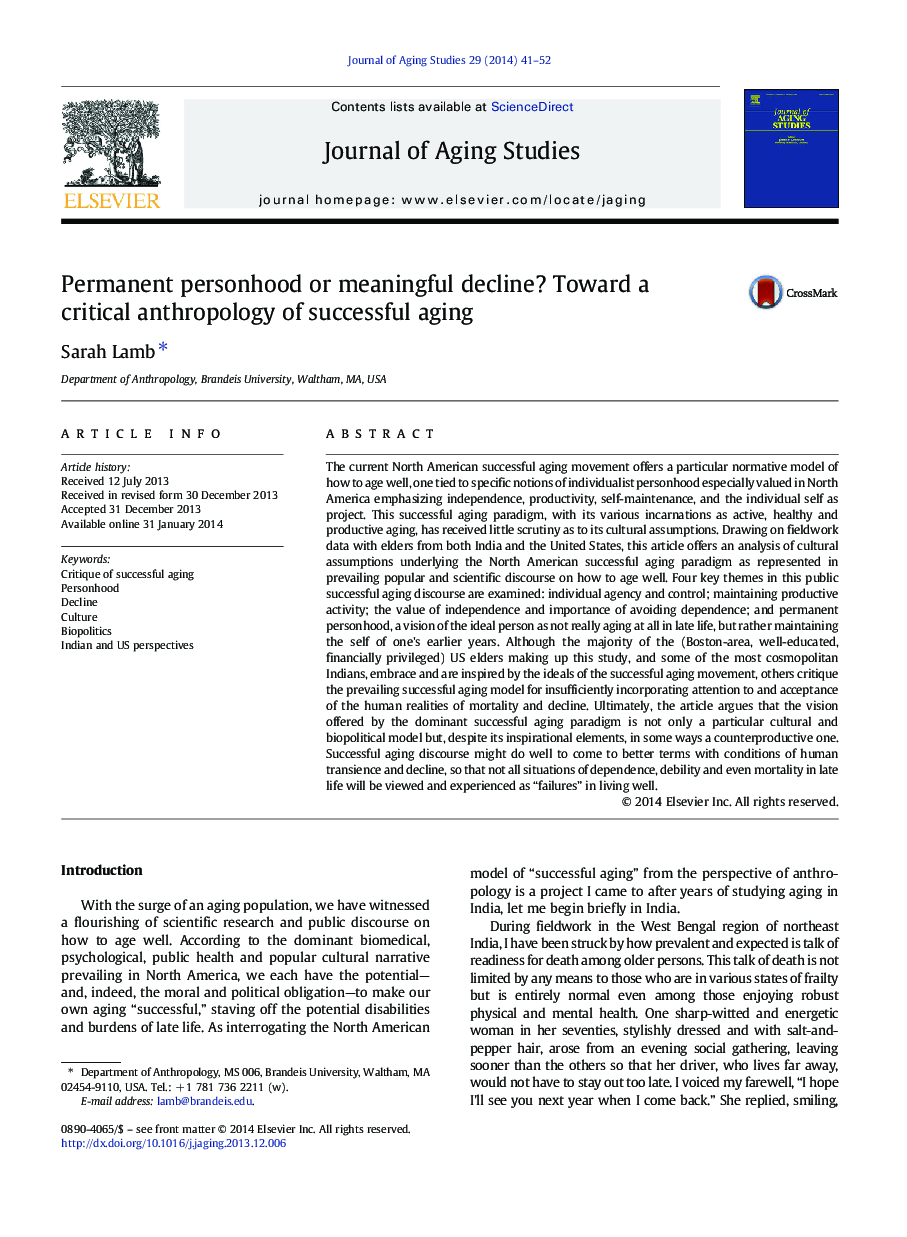| کد مقاله | کد نشریه | سال انتشار | مقاله انگلیسی | نسخه تمام متن |
|---|---|---|---|---|
| 7517804 | 1486772 | 2014 | 12 صفحه PDF | دانلود رایگان |
عنوان انگلیسی مقاله ISI
Permanent personhood or meaningful decline? Toward a critical anthropology of successful aging
ترجمه فارسی عنوان
شخصیت دائمی یا کاهش معنی دار به سوی انسان شناسی انتقادی از پیری موفق
دانلود مقاله + سفارش ترجمه
دانلود مقاله ISI انگلیسی
رایگان برای ایرانیان
کلمات کلیدی
نقد پیری موفق، شخصیت، کاهش می یابد، فرهنگ، بیوپولتیک، دیدگاههای هند و آمریکا،
ترجمه چکیده
در حال حاضر جنبش پیری موفق آمریکای شمالی یک مدل هنجاری خاص از چگونگی سالخوردگی را ارائه می دهد که یکی از خصوصیات شخصیت فردی است که به ویژه در آمریکای شمالی ارزشمند است و بر استقلال، بهره وری، خودمراقبتی و خود فرد به عنوان پروژه اهمیت دارد. این پارادایم پیری با عواقب مختلف آن به عنوان پیری فعال، سالم و مولد، به دلائل فرهنگی آن توجه کمی کرده است. این مقاله با استفاده از داده های داده های میدانی با بزرگان هند و ایالات متحده، این مقاله تحلیلی از مفروضات فرهنگی مبنی بر پارادایم پیری موفقیت آمیز آمریکای شمالی را ارائه می دهد که در گفتمان غالب و علمی در مورد چگونگی سالخوردگی نشان داده شده است. چهار موضوع کلیدی در این گفتمان پیرامون موفقیت عمومی مورد بررسی قرار گرفته است: آژانس و کنترل فردی؛ حفظ فعالیت تولیدی؛ ارزش استقلال و اهمیت اجتناب از وابستگی؛ و شخصیت دائمی، یک دیدگاه از فرد ایده آل است که در اواخر عمر سالم نیست، بلکه خود را در سالهای اولیه خود حفظ می کند. اگر چه اکثریت از بزرگان ایالات متحده (منطقه بوستون، تحصیل کرده و ممتاز) که این مطالعه را تشکیل می دهند و بعضی از سرزمین کلان شهرها، آرمان های جنبش پیری را در بر می گیرند، از دیگران الهام می گیرند؛ مدل پیری برای کمبود توجه و پذیرش واقعیت های انسانی مرگ و میر و کاهش. در نهایت، مقاله استدلال می کند که دیدگاه ارائه شده توسط پارادایم پیشرفته پیرامون پیشرفته نه تنها یک مدل فرهنگی و بیوپولتیک خاص است، بلکه با وجود عناصر الهام بخش آن، به نوعی یک اثر متضاد است. گفتمان سالخوردگی موفق ممکن است به شرایط بهتر با شرایط زودگذر و کاهش زیستمحیطی بپردازد، به طوری که نه همه شرایط وابستگی، بی ثباتی و حتی مرگ و میر در اواخر زندگی، به عنوان یک شکست ناپذیر شناخته شده و تجربه خواهند شد. در زندگی خوب است
موضوعات مرتبط
علوم پزشکی و سلامت
پزشکی و دندانپزشکی
طب سالمندان و علم پیری شناسی
چکیده انگلیسی
The current North American successful aging movement offers a particular normative model of how to age well, one tied to specific notions of individualist personhood especially valued in North America emphasizing independence, productivity, self-maintenance, and the individual self as project. This successful aging paradigm, with its various incarnations as active, healthy and productive aging, has received little scrutiny as to its cultural assumptions. Drawing on fieldwork data with elders from both India and the United States, this article offers an analysis of cultural assumptions underlying the North American successful aging paradigm as represented in prevailing popular and scientific discourse on how to age well. Four key themes in this public successful aging discourse are examined: individual agency and control; maintaining productive activity; the value of independence and importance of avoiding dependence; and permanent personhood, a vision of the ideal person as not really aging at all in late life, but rather maintaining the self of one's earlier years. Although the majority of the (Boston-area, well-educated, financially privileged) US elders making up this study, and some of the most cosmopolitan Indians, embrace and are inspired by the ideals of the successful aging movement, others critique the prevailing successful aging model for insufficiently incorporating attention to and acceptance of the human realities of mortality and decline. Ultimately, the article argues that the vision offered by the dominant successful aging paradigm is not only a particular cultural and biopolitical model but, despite its inspirational elements, in some ways a counterproductive one. Successful aging discourse might do well to come to better terms with conditions of human transience and decline, so that not all situations of dependence, debility and even mortality in late life will be viewed and experienced as “failures” in living well.
ناشر
Database: Elsevier - ScienceDirect (ساینس دایرکت)
Journal: Journal of Aging Studies - Volume 29, April 2014, Pages 41-52
Journal: Journal of Aging Studies - Volume 29, April 2014, Pages 41-52
نویسندگان
Sarah Lamb,
